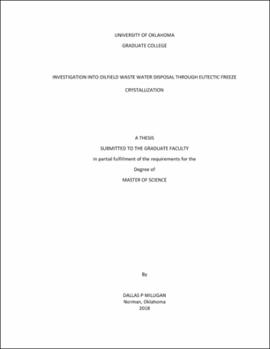| dc.description.abstract | The principal question for this thesis is as follows:
“How can freeze crystallization be utilized to treat flowback and produced water from oilfield operations?”
Current waste water disposal methods in the oil industry primarily include water injection into disposal wells, with limited utilization of electrocoagulation for in-field reuse and thermal distillation at refineries. Brine hypersalinity and residual hydrocarbon has limited the application of membrane technology and simple environmental expulsion is heavily regulated by the EPA [2]. The problems associated with injection disposal, coupled with a lack of nearby Class II injection wells has limited the development of the Pennsylvanian Marcellus Shale Gas due to economic constraints imposed largely by the cost of water disposal. The challenge gas producers must now face is how to preserve the economics of shale gas production while simultaneously upholding responsible stewardship of resources and protecting public health. With increased concerns regarding induced seismicity from injection wells and the safety of that type of disposal, the need for water recycling methods has grown.
Eutectic Freeze Crystallization (EFC) has the potential to treat complex, hypersaline co-produced brine and represents a sustainable water treatment technology towards achieving a near zero waste by producing potable water and pure salts [3]. Given that the hypersaline brines of the Marcellus Shale are sodium and chloride rich [4], EFC could be used to selectively recover the sodium as a pure sodium chloride salt while simultaneously producing pure ice crystals. The pure ice would have innumerable uses; reuse for hydraulic fracturing, release into estuaries, and agriculture being only a few.
The sodium chloride salt represents a potential revenue stream for water treatment companies and its sale to industrial chemical synthesizers could offset the cost of water treatment. While the applicability of using EFC to remove multiple salts from complex multi-component, hypersaline brines has not yet been demonstrated [5], the thermodynamics of freeze crystallization are extensively known. Verbeek shows that the overall efficiency an EFC crystallizer is 59% and that the energy requirement per unit feed is comparable to that of typical commercial evaporative crystallizers [6]. The cost of a large-scale freeze crystallization facility is estimated to be equitable to that of evaporative crystallization [7], but to be competitive EFC needs to be comparable to the injection disposal cost of $1.00 - $6.50 per barrel to be of interest to Exploration and Production companies [8].
Original simulation research of eutectic freeze crystallization of produced water using OLI Stream Analyzer was performed on various brine compositions generated from water quality reports provided by Baker Hughes Inc. This analysis shows EFC is suited for desalination of co-produced waters. These results indicate that EFC has a high level of compatibility with the task of co-produced water desalination and can be applied under favorable economic situations. A statistical cost estimate for water treatment by EFC is performed and concludes that if not currently economically viable, in the near future EFC will be financially feasible in the Middle-Atlantic Region for shale gas water treatment.
Additional research needs to be performed to complete the validation of EFC for the task of treating brines for release. Namely, it is unclear to date whether the presence of hydrocarbons, organic chemicals and biomass, fracturing fluid chemicals and other additives, or NORM material would interfere or contaminant the pure effluent streams of EFC. In Chapter 4 a research proposal to finish the validation of this method is included.
The major findings are:
• The co-formation of other salts near the eutectic point of hydrohalite can be limited through the mixing of waste water streams from multiple wells
• An average Marcellus/Utica brine exhibits first the formation of ice, followed by eutectic co-formation of hydrohalite and ice
• Marcellus produced water volumes in Pennsylvania are expected to raise to 71 MMbbl by 2022
• The nonrecoverable energy requirement for an average Marcellus Shale produced water stream is 179kWh/m3
• The cost of EFC treatment in the Middle-Atlantic Region is estimated to be $1.93/bbl
• When accounting for recovered costs from the potential sale of crystallized salt the treatment cost is reduced to $0.82/bbl, similar to that of membrane distillation [9] | en_US |
